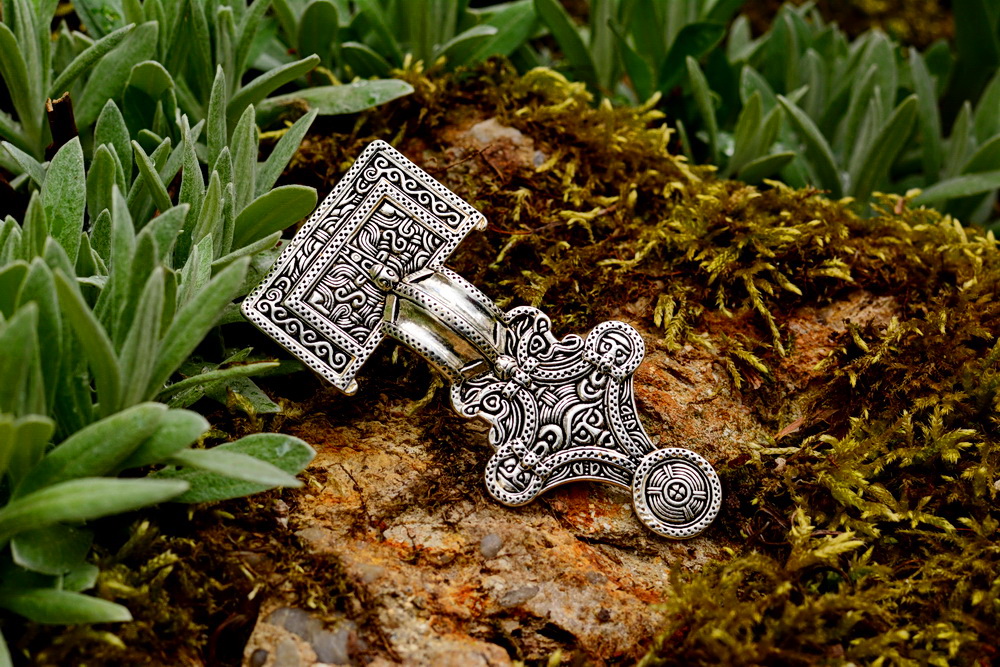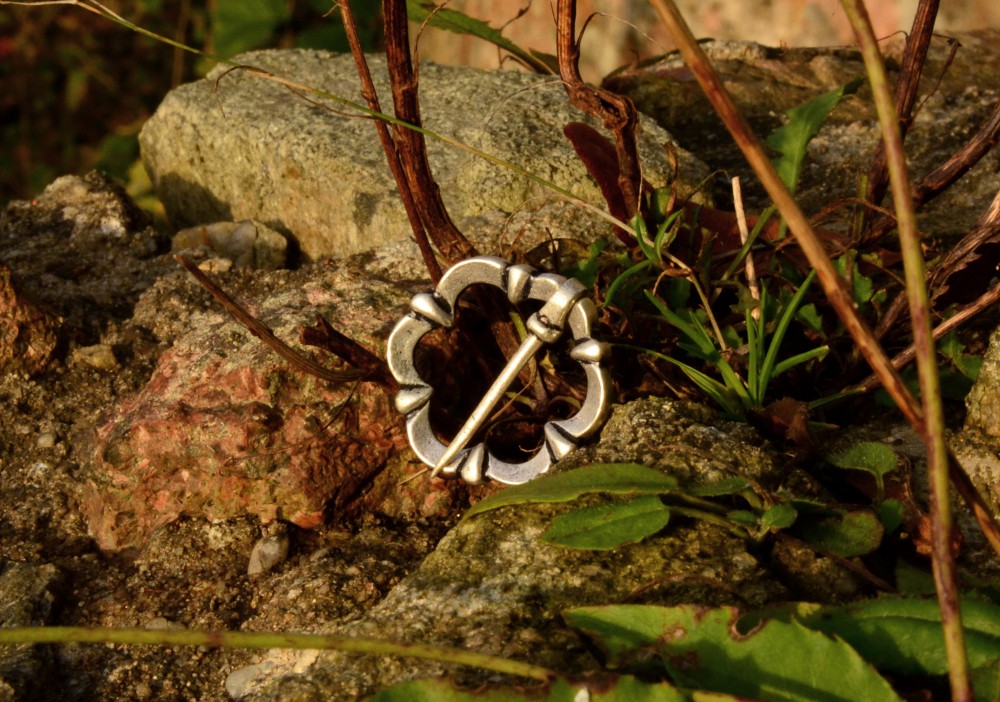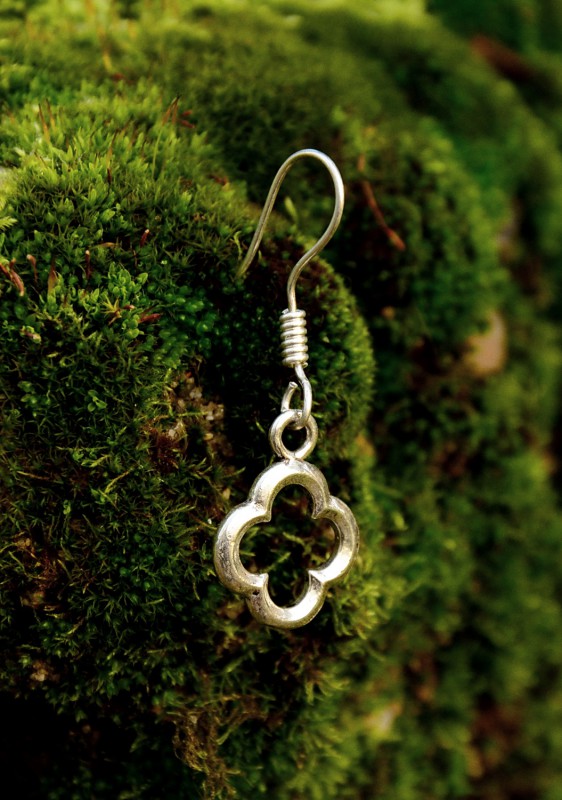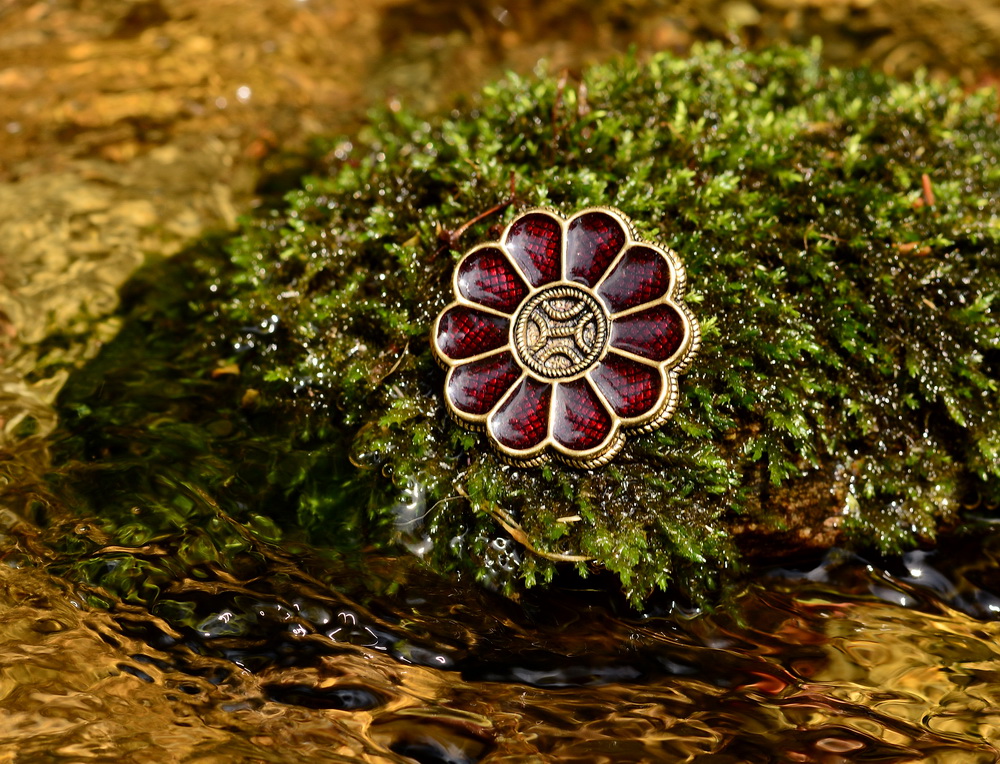The beauty of medieval jewelry
Here we show beautiful pictures of our medieval jewelry replicas like brooches, fibulas, armrings and earrings for living history and medieval re-enactment – offered in wholesale and retail by Pera Peris – House of History on www.peraperis.com.
 Square headed brooch replica...
Square headed brooch replica...
This beautiful and fine detailed Anglo-Saxon brooch replica is made along the liones to one of on of the most beautiful great square-headed brooches of the anglo saxon period.
The brooch was found in 1855 in the grave of a woman and was probably made in the first quarter of the sixth century.
Today the square headed brooch is shown in the exhibition of the british Museum in London.
 Cuthbert Cross Pendant...
Cuthbert Cross Pendant...
The beautiful, medieval cross pendant is made along the lines of the famous Cuthbert cross from the years 640 to 670 AD. The cross is a smaller copy of the historic original, which Cuthbert had once worn.
Cuthbert of Lindisfarne was a monk and later bishop of the cloister Lindisfarne. He is said to have worked many miracles and is still revered as a saint.
He was ultimately the prior of the monastery of Lindisfarne. After his death Cuthbert was buried in the monastery church. 200 years later in 793, the Vikings conquered the region and the monks were forced to flee, they took the Cuthberts body with them and found a resting place for him in Chester.
 Medieval Brooch of the Uta from Naumburg...
Medieval Brooch of the Uta from Naumburg...
This remarable medieval brooch was made along the line of the historical sample of the famous statue of Uta - one of the founding figures of the Naumburg Cathedral.
Such brooches were worn during the 14th century in many parts of Europe by men and women in order to close the neckline of medieval garbs.
 Medieval brooch replica from Fuchsenhof ...
Medieval brooch replica from Fuchsenhof ...
This beautiful replica of a medieval brooch is better known as six pass fuerspan and was found in the treasure trove of Fuchsenhof in Austria.
This special typ of brooch was widely used in the high middles age between the 13th and 14th century in many parts of Europe and was equally worn by men and women in order to close the neck of the medieval garb.
The treasure trove of Fuchsenhof dates from around 1270 and was a rich medieval silver treasure. It mainly consists of coins and jewelery and is one of the largest jewelry finds from the middle ages at all.
 Sutton Hoo Brooch...
Sutton Hoo Brooch...
This beautiful Anglo-Saxon brooch is made according to a harness mount which was found in the ship burial of Sutton Hoo in East Anglia which dates to the anglo saxon period arround 650 AD.
Today it’s believed that this burial owns to the anglo saxon ruler Raedwald of East Anglia († 617-625), although this is not completely certain.
 Medieval Earring quatrefoil...
Medieval Earring quatrefoil...
Quatrefoil shaped ear ring in the shape of medieval tracery which was an invention of the Gothic architecture and became one of the main characteristics of medieval art and an indispensable part of the early architecture mastership.
 Merovingian Rosette Brooch with Cloisonné...
Merovingian Rosette Brooch with Cloisonné...
Replica of an Alamannic rosette brooch with cloisonné from the Merovingian period
which was found at the early medieval cemetery of Bopfingen in Germany dating back to the 6th century.
During the early middle ages Such almandine decorated disc brooches belonging to the costume of the wealthy Merovingian woman. The were usualy used in pairs and closed the top of the garb, added by a pair of bow brooches for the lower part, which is known as the Merovingian four fibua costume.
 Medieval cross fibula replica...
Medieval cross fibula replica...
This replica of an early medieval cross fibula is better known as cruciform shaped brooch and was wide spread in Skandinavia during the 5th century. It was used in pairs for closing the Peplos which was worn by Germanic women.
Also in Anglo-Saxon England such cruciform brooches were often found, caused by the skandinavian influences during that time.
 Merovingian Bow Brooch...
Merovingian Bow Brooch...
This beautiful replica of a Merovingian bow brooch is also known as radiate zoomorphic fibula.
This typical Frankish bow fibula is expected to be made in the western Alemannic area in south Germany and dated to the time between 550 and 650 when the Alemannic tribes came increasingly under Frankish influence.
During the Merovingian period this type of bow brooches were worn in the early Middle Ages from West Germanic women to close the tunic near the waist and were usually combined with two smaller s-fibulas or rosette brooches near the chest.
 Medieval Quatrefoil brooch replica...
Medieval Quatrefoil brooch replica...
Replica of a small quatrefoil shape brooch, a so called fuerspan, according to a medieval find from Kent in England dating back to the Middle Ages from the 13th to 14th century. Such Medieval jewelery in the shape of a quatrefoil was widespread in the Middle Ages and were equally worn in many parts of Europe by men and women in order to close off the neck of the medieval clothes.
 Merovingian S-shaped Fibula replica of the Franks...
Merovingian S-shaped Fibula replica of the Franks...
Replica of a Merovingian S-shaped brooch with cloisonné along the lines of an early medieval find from the 6th century found in Ascheim / Germany.
The S-shaped fibula was widespread among the merovingian Germanic tribes of the Bavarians, Alemanni and Longobards and was an integral part of the medieval garb during the 5th to the 7th century. An almost identical sample like the fibula from Aschheim has been found also in the cemetery Maria Ponsee in Austria.
 Medieval brooch of the Eve from Reims...
Medieval brooch of the Eve from Reims...
Medieval brooch based on the presentation of the statue of Eve at the Cathedral at Reims. This beautiful medieval jewelry is a so-called quatrefoil Fuerspan which were a typical jewelry of the Middle Ages between the 13th and 14th century.
The model for this medieval brooch is the famous figure of Eve from the Cathedral at Rheims in Germany.
This type of medieval jewelry was used to close the neckline of the garb and was worn by men and women alike in whole Europe during the midlle ages.
 Medieval Fuerspan Brooch...
Medieval Fuerspan Brooch...
A typical medieval jewelry, called Fuerspan, which was common during the Middle Ages between the 13th and 14th century and used to close the neckline of the garb.
This type of medieval brooch was worn by men and women alike in whole Europe during the high midlle ages.


 Square headed brooch replica...
Square headed brooch replica...This beautiful and fine detailed Anglo-Saxon brooch replica is made along the liones to one of on of the most beautiful great square-headed brooches of the anglo saxon period.
The brooch was found in 1855 in the grave of a woman and was probably made in the first quarter of the sixth century.
Today the square headed brooch is shown in the exhibition of the british Museum in London.
 Cuthbert Cross Pendant...
Cuthbert Cross Pendant...The beautiful, medieval cross pendant is made along the lines of the famous Cuthbert cross from the years 640 to 670 AD. The cross is a smaller copy of the historic original, which Cuthbert had once worn.
Cuthbert of Lindisfarne was a monk and later bishop of the cloister Lindisfarne. He is said to have worked many miracles and is still revered as a saint.
He was ultimately the prior of the monastery of Lindisfarne. After his death Cuthbert was buried in the monastery church. 200 years later in 793, the Vikings conquered the region and the monks were forced to flee, they took the Cuthberts body with them and found a resting place for him in Chester.
 Medieval Brooch of the Uta from Naumburg...
Medieval Brooch of the Uta from Naumburg...This remarable medieval brooch was made along the line of the historical sample of the famous statue of Uta - one of the founding figures of the Naumburg Cathedral.
Such brooches were worn during the 14th century in many parts of Europe by men and women in order to close the neckline of medieval garbs.
 Medieval brooch replica from Fuchsenhof ...
Medieval brooch replica from Fuchsenhof ...This beautiful replica of a medieval brooch is better known as six pass fuerspan and was found in the treasure trove of Fuchsenhof in Austria.
This special typ of brooch was widely used in the high middles age between the 13th and 14th century in many parts of Europe and was equally worn by men and women in order to close the neck of the medieval garb.
The treasure trove of Fuchsenhof dates from around 1270 and was a rich medieval silver treasure. It mainly consists of coins and jewelery and is one of the largest jewelry finds from the middle ages at all.
 Sutton Hoo Brooch...
Sutton Hoo Brooch...This beautiful Anglo-Saxon brooch is made according to a harness mount which was found in the ship burial of Sutton Hoo in East Anglia which dates to the anglo saxon period arround 650 AD.
Today it’s believed that this burial owns to the anglo saxon ruler Raedwald of East Anglia († 617-625), although this is not completely certain.
 Medieval Earring quatrefoil...
Medieval Earring quatrefoil...Quatrefoil shaped ear ring in the shape of medieval tracery which was an invention of the Gothic architecture and became one of the main characteristics of medieval art and an indispensable part of the early architecture mastership.
 Merovingian Rosette Brooch with Cloisonné...
Merovingian Rosette Brooch with Cloisonné...Replica of an Alamannic rosette brooch with cloisonné from the Merovingian period
which was found at the early medieval cemetery of Bopfingen in Germany dating back to the 6th century.
During the early middle ages Such almandine decorated disc brooches belonging to the costume of the wealthy Merovingian woman. The were usualy used in pairs and closed the top of the garb, added by a pair of bow brooches for the lower part, which is known as the Merovingian four fibua costume.
 Medieval cross fibula replica...
Medieval cross fibula replica...This replica of an early medieval cross fibula is better known as cruciform shaped brooch and was wide spread in Skandinavia during the 5th century. It was used in pairs for closing the Peplos which was worn by Germanic women.
Also in Anglo-Saxon England such cruciform brooches were often found, caused by the skandinavian influences during that time.
 Merovingian Bow Brooch...
Merovingian Bow Brooch...This beautiful replica of a Merovingian bow brooch is also known as radiate zoomorphic fibula.
This typical Frankish bow fibula is expected to be made in the western Alemannic area in south Germany and dated to the time between 550 and 650 when the Alemannic tribes came increasingly under Frankish influence.
During the Merovingian period this type of bow brooches were worn in the early Middle Ages from West Germanic women to close the tunic near the waist and were usually combined with two smaller s-fibulas or rosette brooches near the chest.
 Medieval Quatrefoil brooch replica...
Medieval Quatrefoil brooch replica...Replica of a small quatrefoil shape brooch, a so called fuerspan, according to a medieval find from Kent in England dating back to the Middle Ages from the 13th to 14th century. Such Medieval jewelery in the shape of a quatrefoil was widespread in the Middle Ages and were equally worn in many parts of Europe by men and women in order to close off the neck of the medieval clothes.
 Merovingian S-shaped Fibula replica of the Franks...
Merovingian S-shaped Fibula replica of the Franks...Replica of a Merovingian S-shaped brooch with cloisonné along the lines of an early medieval find from the 6th century found in Ascheim / Germany.
The S-shaped fibula was widespread among the merovingian Germanic tribes of the Bavarians, Alemanni and Longobards and was an integral part of the medieval garb during the 5th to the 7th century. An almost identical sample like the fibula from Aschheim has been found also in the cemetery Maria Ponsee in Austria.
 Medieval brooch of the Eve from Reims...
Medieval brooch of the Eve from Reims...Medieval brooch based on the presentation of the statue of Eve at the Cathedral at Reims. This beautiful medieval jewelry is a so-called quatrefoil Fuerspan which were a typical jewelry of the Middle Ages between the 13th and 14th century.
The model for this medieval brooch is the famous figure of Eve from the Cathedral at Rheims in Germany.
This type of medieval jewelry was used to close the neckline of the garb and was worn by men and women alike in whole Europe during the midlle ages.
 Medieval Fuerspan Brooch...
Medieval Fuerspan Brooch...A typical medieval jewelry, called Fuerspan, which was common during the Middle Ages between the 13th and 14th century and used to close the neckline of the garb.
This type of medieval brooch was worn by men and women alike in whole Europe during the high midlle ages.



